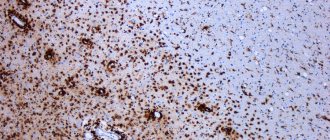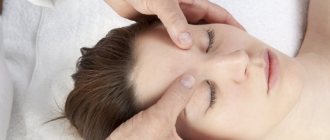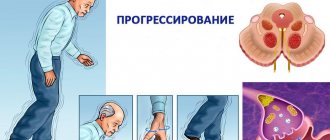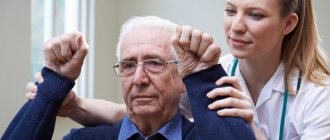- How is PLS diagnosed?
- What examinations are carried out
- Symptoms
- Forecast
- How does the disease progress?
- How to deal with PLS
- Exercises
- Speech
- Eating
Primary lateral sclerosis is a disease that affects the motor neurons in the brain that control voluntary movements. Degradation of these neurons causes gradual deactivation of spasticity and muscle weakness.
Motor neurons, upper and lower
Amyotrophic lateral sclerosis (ALS) is the most common type of motor neuron disease.
Motor neurons are cells that carry information from the central nervous system to the muscles. They can reach 1 meter in length.
Upper motor neurons are located in the cerebral cortex. Their processes (axons) descend into the spinal cord, where they contact the neurons of the spinal cord.
Neurons in the spinal cord (lower motor neurons) use processes to transmit signals to the muscles and control their contractions. Depending on their location, they are responsible for the movement of the arms, legs, torso, contraction of the diaphragm, breathing, swallowing, etc.
In ALS, motor neurons in both the brain and spinal cord are affected and killed.
The average age of patients is 45 years, but there are also much younger patients. Thus, American composer and guitarist Jason Becker was diagnosed with ALS at the age of 20.
The disease occurs in 5-7 people per 100 thousand population. Every 90 minutes, a new case of ALS is diagnosed around the world.
There are twice as many cases of men as women.
“How can we write out something we don’t have?”
On February 21, Vladimir Frolov was admitted to the intensive care unit of the Syzran City Hospital with worsening bronchopulmonary spasm. “When grandfather was hospitalized, we were told that that evening or, in extreme cases, the next day, his respiratory tract would be sanitized and he would be transferred to the neurological department,” says Ilya Frolov. “As a result, he spent six days in intensive care. At the same time, only the upper respiratory tract was sanitized - and for this they put the person in intensive care! The doctors there don’t know the tactics for managing ALS, I heard them discussing among themselves what to do.
In fact, my grandfather did not need to be in intensive care - he was conscious, could take care of himself, go to the toilet on his own, he just needed to remove mucus from his respiratory tract. But they tied his hands to the bed and placed a urine bag so that he would not get up and so that he would not have to change his diapers.
They began giving him oxygen, although this cannot be done with ALS. To my objections they answered: “Nothing terrible will happen.” Even in the discharge it was written that he needed long-term oxygen therapy. We were not allowed to see him, although this was before the quarantine was announced. He lay all alone for a week.”
Famous people with ALS
Mao Zedong.
Photo from pinterest.ru Mao Zedong (1893-1976) - Chinese politician. At the age of 80, he was diagnosed with ALS, but died two years later from a heart attack.
Lou Gehrig (1903-1941) was an outstanding American baseball player. He was diagnosed with ALS at age 36, in 1939.
Dmitry Shostakovich (1906-1975) is a great composer. He suffered from ALS for about ten years and died of a heart attack.
Stephen Hawking (1942-2018) is a famous British physicist. Lived with ALS for over 50 years.
Vladimir Migulya (1945-1996) – composer, author of music for the songs “Grass at the House”, “Talk to Me, Mom”, “Stuntmen”, etc. The disease was discovered in 1993.
Jason Becker (born 1969) is an American composer and guitar virtuoso. He fell ill with ALS at the age of 20, in 1989.
Fernando Ricksen (born 1976) is a Dutch footballer. He was diagnosed with ALS in 2013 and lost the ability to speak in 2021.
Live now
Living with a rare disease is usually a huge expense. For PALS, for example, the average “estimate” looks like this: hygiene products and special food - about 100 thousand per month, breathing apparatus - 350-400 thousand rubles, consumables - at least 10 thousand per month, cougher and saliva ejector - another half a million. Plus a functional bed, an anti-decubitus mattress and other devices that will make the life of the sick person and his loved ones a little more comfortable.
Sometimes one of the above can be achieved from the state. But most of the expenses fall on the shoulders of the family. And besides this, there is the despondency and isolation that comes with the disease.
Tatyana Shestimerova has been suffering from ALS for 20 years. She learned about her diagnosis while pregnant with her second child. She and her husband Pavel learned to live with ALS even before the Live Now Foundation appeared in Russia, and their family became a source of inspiration and optimism for hundreds of families across the country who faced the same diagnosis. There are many videos on YouTube that spouses record to share their experiences of living with ALS with other families.
“The disease is an unpleasant thing,” says Tatyana. “But don’t paint yourself into a corner ahead of time.” I have a rare case: I have had ALS for 20 years, which is a very long time. And I am sure that one of the main reasons here is that my family and I built the right relationship with the disease: we accepted it as a certain circumstance of life, did not isolate ourselves in it, but continued to communicate with friends, go to the country, receive guests, receive enjoy every day."
Photo: Vladimir Eshtokin
Who's at risk
Stephen Hawking.
Photo from pinterest.ru The disease was first described in 1869 by the Frenchman Jean-Martin Charcot, but it is still poorly understood. In each case, its triggering mechanisms may be different.
There are hereditary forms of ALS, and then the main cause is a mutation in a specific gene. When making a diagnosis, a neurologist usually asks whether any other family members have suffered from amyotrophic lateral sclerosis or frontotemporal dementia (the same genetic “breakage” leads to it).
But in the vast majority of patients (90-95%), none of the relatives suffered from these diseases. Moreover, in 10% of these people the mutation is still detected - it occurs for the first time in them, and is not transmitted from their parents.
There is a hypothesis that there is a connection between the non-hereditary form of ALS and certain injuries, high stress in sports, and agricultural chemicals.
But clear conclusions have not yet been made, since many data are inconsistent with each other.
The only known risk group is children of sick parents with an established mutation that caused the development of ALS. They inherit the damaged gene with a 50% probability. But a gene mutation does not necessarily lead to ALS.
Saliva and phlegm
What's happening? When swallowing is impaired, excess saliva accumulates in the oral cavity, which leads to drooling and the associated feeling of discomfort. The consistency of the secretion can be either watery or thick. Increased viscosity is associated with a decrease in the amount of fluid entering the body. In this case, saliva is removed with great difficulty. Dry mouth may also develop due to medications, dehydration, mouth breathing, or mucosal candidiasis.
What can be done? Options for solving this problem include dietary adjustments, drug therapy, and the use of aspiration devices for cleaning the oral cavity (suction).
Learn more about how to control salivation
Weakness in the legs
Dmitry Shostakovich.
Photo from pinterest.ru ALS is very difficult to diagnose. Firstly, because it is a rare disease that doctors are poorly aware of. Secondly, early symptoms are quite minor: clumsiness, clumsiness in the hands, slightly slurred speech. Thirdly, the disease manifests itself differently in each patient.
The first and most common symptoms of ALS are weakness in the arms or legs. Objects begin to fall out of the hands, the person stumbles when walking, and drags his foot. There is a sensation of muscle contractions under the skin (fasciculations). Painful cramps and spasms may occur. Fatigue increases.
Difficulties begin with speech, swallowing, and chewing. It becomes difficult to breathe.
Some ALS patients may cry or laugh involuntarily. The reasons for this are not psychological, but physiological: the disease affects areas responsible for emotional reactions. Sometimes there are problems with memory and concentration.
Muscle cramps and spasms
What's happening? Due to the deterioration of signal transmission from motor neurons, muscle tension or spasms develops. This leads to impaired motor activity and coordination of movements, as well as an increased risk of falls. Sudden muscle spasms can be extremely painful.
What can be done? To eliminate this symptom, as a rule, it is enough to change the position of the body while resting in a bed or chair. Exercise partially solves the problem. In addition, your doctor may prescribe medications to relax your muscles.
Find out more in the material “Pain in ALS”
What tests are performed to make a diagnosis?
Photo: Flickr.com/ec-jpr
If the therapist suspects that a person has amyotrophic lateral sclerosis, he will send him to a neurologist, who will prescribe a series of examinations:
– a blood test (will show whether the level of creatine kinase, an enzyme that is produced when muscle tissue is destroyed), is elevated;
– magnetic resonance imaging (does not reveal specific changes in ALS, is used to exclude diseases with symptoms similar to ALS);
– electroneuromyography (registration of electrical activity of muscles);
If necessary, additional examinations such as a lumbar puncture or muscle biopsy may be performed.
Violation of higher mental functions
What to do? Problems with memory, learning, word-finding, or decreased concentration are known as higher mental function disorders. According to some data, these conditions occur in 35% of patients with ALS, but occur rather unnoticed. Only in a few are they extremely pronounced. In this case, we talk about frontotemporal dementia, which is accompanied by severe impairment of cognitive functions.
What can be done? The participation of a multidisciplinary team of specialists, including psychologists and psychiatrists, is necessary.
Learn more about higher mental functioning disorders in ALS
Want to discuss your symptoms or learn more about ALS? You can call the ALS Helpline by phone or +7. E-mail (for residents of Moscow and Moscow Region) [email protected] (for residents of other regions) Help service for people with ALS in St. Petersburg Tel.: +7 931 971 56 21E-mail
What happens to the patient
Photo from the site syl.ru
The average life expectancy for ALS is from two to five years from the moment the first symptoms appear. There are cases when the disease lasts several decades. For example, Stephen Hawking lived with ALS for more than 50 years. And there are patients who leave a few months after the diagnosis is made.
As ALS progresses, a person experiences increasingly serious difficulties with moving, speaking, swallowing, and breathing. Therefore, doctors advise relatives to immediately adapt housing for the patient and buy special equipment.
If the disease begins in the legs, then at first it becomes difficult for the patient to walk and maintain balance; he may lean on pieces of furniture, so they must be stable. Then the patient begins to use a walker or wheelchair, and it is important to free up space in the house for this.
Gradually, it becomes difficult for a person to raise his arms, so it is recommended to place all necessary things no higher than 1 m from the floor. There are adapted forks, spoons and knives with thicker handles and even with straps; they allow the patient to go longer without assistance when eating.
To communicate with the outside world, such patients eventually have to resort to special devices. Stephen Hawking, for example, used a special computer system that was controlled by the cheek muscle. And Jason Becker uses a board with letters that he points to with his eyes. Many people benefit from the Tobii device, which connects to a regular computer and allows you to move the cursor and type on the keyboard with your eyes.
Sooner or later, a person's respiratory muscles are affected and he loses the ability to breathe on his own. Then there is a need for breathing equipment.
How children with incurable diseases live in Russia
After discharge, Ilya and his grandfather came to an appointment with the deputy head physician of Tolyatti Hospital No. 5, Vladimir Kozlov. “I said that my grandfather would not be able to go to the hospital every day in this condition for a bronchoscopy. He asked what we should do and why they didn’t prescribe us a cough cougher,” says Ilya Frolov. “He answered: “How can we prescribe something that we don’t have? We have never worked with this equipment, we have never used it - how can we assign it?
Director of the Live Now Foundation Natalya Lugovaya advises doctors who ask such questions to carefully read the appendix to the Regulations on the organization of palliative medical care dated May 31, 2021 No. 345n/372n, which states that the hospital must have at least one insufflator - exsufflator - that is, a cougher.
Soon after Vladimir Frolov was discharged from the Togliatti hospital, Vasily Shtabnitsky conducted a remote consultation with the patient, at which he confirmed the recommendations of Evgeny Kirilin two months ago: only now the patient urgently needed a NIV machine and a cough cougher.
Pulmonologist Shtabnitsky names the inability of doctors to handle the equipment needed for rare diseases as one of the reasons why many patients in the regions do not receive quality medical care. “Let's assume that somewhere they don't operate on appendicitis, because they've never done it before, and that's why all the patients die from appendicitis,” he says. “So maybe it's time to start learning? For the first operation, call a doctor from a neighboring city, do the second under his supervision, and the third - on your own. Then people in this place will stop dying from appendicitis. It’s the same with a cougher - it won’t adjust itself, but you can learn it.”
What helps with ALS
Photo from als-info.ru
ALS remains an incurable disease. Doctors can only prolong a patient’s life and improve its quality.
Riluzole is a medicine that can slightly slow down the progression of ALS (provided the person starts taking it in the early stages of the disease). This drug is not registered in Russia.
Mechanical ventilation also increases the life expectancy of people with ALS. In addition, it improves sleep, reduces shortness of breath and fatigue. There is non-invasive pulmonary ventilation (NIV), in which a special device pumps air into a face mask. Invasive ventilation uses a tracheostomy, which almost completely deprives a person of the ability to speak.
Many people with ALS find it very difficult to eat and drink. To compensate for the lack of calories and fluid, special therapeutic nutrition is used. When it becomes difficult for a person to swallow even homogeneous food, a gastrostomy is placed - a special tube through which food enters directly into the stomach.
A neurologist may prescribe medications to the patient to reduce muscle spasms, as well as medications to reduce fasciculations. Morphine-containing drugs are prescribed to reduce the feeling of suffocation. Sometimes patients with ALS are given antidepressants.
Massage, aromatherapy, and acupuncture help relieve stress and pain. (Naturally, these methods do not treat the disease itself). Physical exercise allows you to maintain muscle function, a sense of balance, and joint mobility longer. However, excessive stress can cause harm, so a set of exercises should be developed under the supervision of a physical therapist or exercise therapy doctor.
What is the role of the caregiver?
Caring for a person with ALS can be quite challenging and challenging.
When symptoms first appear, you should consult your doctor or any other member of your health care team. This will allow the caregiver and the person with ALS to be as knowledgeable as possible and have greater access to the care they need.
Many caregivers reported that they often put their own needs second to the needs of their loved one with ALS. While caring for a patient, it is not always possible to find time for yourself. However, if you are constantly overwhelmed or exhausted, you may soon find yourself in a situation where the caregiver is unable to care for the person with ALS. That is why caregivers need to monitor their own health.
Find out more in the material “Self-preservation, or self-care”
Listed below are the primary care needs of a person with ALS and how caregivers can get involved.
Personal care and housework
As the symptoms of the disease progress, caregivers must take on the work they were previously doing.
Such things may include:
- household chores;
- accompanying a person with ALS during travel;
- financial accounting;
- responsibility for children;
- meeting increased requirements for individual care.
Even if the process of caring for a loved one is enjoyable and other family members or friends help, one day the caregiver may need additional help due to:
- increasing care requirements;
- complication of the needs of a person with ALS, the need for medical manipulations;
- the presence of certain aspects of care that the caregiver or the person with ALS prefers to transfer to someone else;
- the need to care for a person with ALS in the absence of a caregiver, for example, when he goes shopping or is busy with housework;
- possible need for round-the-clock care, which will require the caregiver to rest more.
To help a person with ALS maintain independence for as long as possible, work with a primary care physician and physical therapist to assess the person's needs and identify supports such as equipment, assistive devices, and living accommodations. This will also reduce daily maintenance requirements.
Find out more in the material “Adaptation of an apartment for people with ALS”
Visiting specialists
A person with ALS may need:
- assistance during travel to a medical facility and back (if there are mobility impairments);
- assistance in explaining things to others (if there are speech and communication problems);
- emotional support if a visit to a specialist involves discussing an exciting topic.
A variety of professionals may be involved in the care of a person with ALS, which involves a large number of visits and travel. Even home visits can be quite tedious, creating the feeling of a constant stream of people in the apartment. A good option is outpatient visits, when you can consult with several specialists at once. Such appointments are held approximately once a month by the ALS Patient Assistance Services in Moscow and St. Petersburg.
Find out more in the ALS Help section.
In order not to forget anything and clearly formulate your thoughts at an appointment with a specialist, it is worth making a list of questions in advance. During the appointment itself, it is necessary to record fragments of the conversation, as well as note the date and name of the doctor who made the recommendations. This will allow you to later refresh your memory of the answers to previously asked questions. You can also record the conversation on a voice recorder, smartphone or other device.
Movement and physical activity
As the disease progresses, the muscles lose strength. A person with ALS is likely to develop impairments in grip strength, movement, and mobility.
There is a huge range of different equipment that will allow you to maintain physical activity for as long as possible. This will also help caregivers. Devices such as adapted cutlery and dressing aids greatly facilitate daily care. Supports, stilts, wheelchairs and lifts can help maintain mobility. Some equipment can be rented.
Find out more in the material “Mobility and movement”
When planning care, it is critical to consider the future needs of the person with ALS as the disease progresses rapidly. By the time the ordered equipment is delivered and configured, it may no longer be needed. To avoid disappointment and unnecessary financial costs, it is important to conduct an assessment of the needs of the person with ALS in advance to ensure that the equipment chosen is truly necessary.
Find out more in “Changing Life Plans and Planning Resources”
A physical therapist can assess the needs of a person with ALS to:
- suggest ways to make daily tasks easier;
- provide some devices/equipment with the involvement of medical and social services;
- recommend purchasing additional devices/equipment.
Caregivers may have difficulty moving someone with ALS from one place to another, such as from a wheelchair to a bed. While assistive equipment such as a lift is convenient, it may be worth seeking out the assistance of third-party caregivers at certain times of the day.
Knowing special techniques to help move a person with ALS in the safest way for both the person and the caregiver can also help. A physical therapist or visiting nurse can tell you about them.
Adapting the interior of the house will also make life easier for all family members. Such events include, for example:
- widening doorways to accommodate wheelchairs;
- installation of interfloor lifts;
- organizing one of the rooms as a bedroom.
A physical therapist can assess the suitability of a home for such activities and advise on the best options. It is vital to ensure that any changes made meet the needs of the person with ALS, as any mistakes will result in frustration and unnecessary expense.
Try to consider possible future needs as ALS can progress quickly. For example, stair lifts are very convenient for those who use stilts, but at the same time they are not suitable for a wheelchair.
Find out more in the article “Adaptation of an apartment for people with ALS”
There are organizations that help with financing and purchasing equipment and adaptations. Raising the required amount of money may take some time, so it is recommended to start as early as possible. At this stage, such activities may seem untimely, but it is important to remember the importance of proper planning to ensure that the necessary equipment is available when it is needed.
Travel and transport
As physical activity decreases, traveling will become increasingly difficult. It is worth studying in advance information regarding:
- vehicles for disabled people;
- taxi services offering relevant services;
- ambulance teams or transport companies.
Still, you shouldn’t completely give up pleasant trips immediately after diagnosis. A person with ALS in the early stages of development of the disease can both travel by train and fly by plane. The main thing is to be well prepared for the trip.
Find out more in the article Traveling with ALS
Exercise and Flexibility
If a person with ALS has impaired motor activity, then, in all likelihood, there is also stiffness (inelasticity) of the muscles and limited mobility of the joints. The patient may also experience muscle spasms. Although ALS is not painful, spasms and cramps can be painful.
Exercises, both active and passive (flexing the limbs at the joints with the help of an outsider), help reduce muscle spasms and pain. They cannot stop progressive muscle weakness and disease in general, but in the presence of muscle stiffness they help to temporarily increase the range of motion in the limbs.
In the case of ALS, it is important to avoid overtraining, which can lead to severe fatigue. A physical therapist will be able to assess a person's needs, create and monitor exercise plans, and explain the caregiver's role in these activities.
If a person with ALS continues to experience pain, contact their GP or health and social services team.
Find out more in the material “Pain in ALS”
Speech and communication
Speech, gestures, facial expressions—all of these can be affected by ALS. As a result, the person may have difficulty communicating what they need.
Finding alternative methods of communication requires patience and time on both the part of the caregiver and the patient, which can complicate the relationship between them.
Depending on the needs and preferences of the person with ALS, something as simple as a notepad and pen, flashcards with text and pictures, or alphabet boards may be helpful. There are also modern high-tech tools, such as software that reproduces text typed on the keyboard.
Find out more in the material “Speech Problems with ALS”
If a person with ALS has never used a computer or keyboard, it is worth mastering such a technique before there is an urgent need for it. Having experience will allow you to communicate more confidently and quickly.
The use of high-tech devices always involves a small risk of malfunction, as a result of which they may fail. As a possible alternative, it is worth keeping a notepad, tables and other simple devices on hand at all times.
As with all types of equipment, the needs of the person with ALS must be properly assessed before purchasing any communication aids. Not all solutions are equally suitable for all patients, and some may be prohibitively expensive. Consult your doctor and rehabilitation specialist.
Swallowing problems
Impaired functioning of the muscles of the face, mouth and larynx in people with ALS is often accompanied by the development of swallowing problems. This can cause problems with food and fluid intake, salivary control and cough reflex.
People with ALS may experience the following problems:
- weight loss;
- increasing the duration of meals;
- fatigue;
- increased viscosity or decreased volume of salivary gland secretion;
- salivation;
- dry mouth;
- weakness of the cough reflex or coughing fits;
- moderate or severe feeling of suffocation and aspiration (entry of food or liquid into the respiratory tract).
A person with ALS can ask their health care provider or health care team for a referral to the following:
- a nutritionist will give recommendations on nutrition, types of food, supplements and methods of preparing food;
- Your doctor or nurse will advise you on swallowing techniques, food textures and thickeners to make drinks easier to drink, and tube feeding recommendations.
Find out more in the material “Eating Problems in ALS”
Tube feeding is usually provided by gastrostomy. Once installed, a gastrostomy tube can partially or completely replace oral nutrition.
With a gastrostomy tube in place, a person can still eat and drink normally through the mouth to enjoy the sensation of taste. The decision whether to insert a gastrostomy tube (or tube) or continue to eat orally is up to the person with ALS and requires careful weighing of the risks.
After the appearance of swallowing problems, the issue of installing a gastrostomy tube should be resolved as soon as possible. This must be done before weight loss reaches critical levels.
The decision to use a gastrostomy should be made jointly with the participation of both the patient and the caregiver, and medical and social services. If a person with ALS does not want to have a gastrostomy tube, their doctor and dietitian can provide nutritional advice.
Gastrostomy feeding may require caregiver input while allowing the person with ALS to worry less about their food and fluid needs. This will also reduce the time it takes to eat, if previously it was tiring for both, and the time it takes to bring the food to the desired consistency. Feeding through a gastrostomy tube also avoids aspiration (food and liquid entering the lungs), which is a cause of recurring infections.
Some caregivers talked about how they were ashamed to eat in front of a loved one with a gastrostomy tube. They often try to eat faster or eat separately. If such a problem arises, it is worth discussing the situation with the patient.
Often people with ALS prefer to lead a normal life so that caregivers do not feel stressed while eating. Having a gastrostomy tube will allow the patient to maintain self-confidence in public places where they have to eat or drink.
Find out more in the article “Gastrostomy: nutrition and care for ALS”
Respiratory support
In ALS, the respiratory muscles are also affected.
A person may need to be referred to a specialist for respiratory assessment if they have the following symptoms:
- shallow breathing or feeling short of breath;
- difficulty breathing with a horizontal body position;
- recurrent chest infections;
- weakness of the cough reflex, voice, or nasal breathing;
- sleep disturbance;
- morning headaches;
- nightmares or hallucinations;
- drowsiness during the day or feeling very tired;
- confusion, decreased concentration and memory;
- poor appetite.
Advice and referrals can be obtained from your doctor or health care team member. They will be able to advise:
- breathing and physical exercises;
- methods of maintaining body position;
- coughing techniques;
- drug therapy;
- use of artificial ventilation.
Ventilation is not suitable for everyone. However, this method reduces anxiety about breathing problems, improves sleep and reduces fatigue.
Find out more in the section "Problems with ALS"
Fatigue
Feeling tired and feeling very weak is common in people with ALS. This can cause anxiety and lead to a situation where the caregiver will have to provide much more support to their loved one.
There are several reasons for the development of weakness in patients with ALS:
- progression of muscle weakness makes it difficult to complete daily tasks and increases the time required for this;
- The diagnosis itself and the daily struggles of having ALS can be emotionally challenging to process;
- problems swallowing can cause food refusal and therefore lack of nutrients (see Eating problems);
- breathing problems can cause sleep disturbances and fatigue (see NIV for ALS);
- there may be another underlying cause that requires diagnosis.
If a person with ALS often experiences fatigue, they should seek advice from their healthcare provider.
Try to schedule social events for times when the sick person is in the best mood. Be flexible in your daily activities. Concentrate on the critically important things, and the rest, less important ones, can be entrusted to other people.
Find out more in the material “Fatigue and weakness in ALS”
Caregivers may also experience significant fatigue, so they need to be mindful of their own energy levels. If you are constantly tired, you should consult your doctor.
The caregiver may need additional assistance.
Find out more in the material “Self-preservation, or self-care”
Emotional support
A diagnosis of ALS can come as a huge shock to both the person affected and the caregiver, especially if they are a spouse, relative, or friend. In some cases, after a period of uncertainty there is a feeling of relief, but most people around, including family members and friends, need time to come to terms with the new situation. Of course, strong emotional reactions are normal and expected.
Such reactions can be mixed: people may experience feelings of sadness, sadness, guilt, anger and fear. This happens differently for each person depending on age, circumstances, culture, faith and level of closeness to the person diagnosed.
Open discussion of the problem gives a kind of “permission” to other loved ones to express their emotions and find ways of mutual support. Laughter and tears are natural reactions that often help relieve tension.
If a strong emotional reaction persists longer than usual and causes discomfort, you should consult your doctor. You can also contact a psychologist. Hospice staff or palliative care professionals can also provide emotional support, help manage symptoms, and give practical advice.
If the relationship between the caregiver and the ALS patient was strained before diagnosis, it is worth seeking professional help. Health and social services staff can help you organize difficult discussions about the problem and work together to find a solution. Additional care assistance may be needed.
Despite the shock of the diagnosis and the difficult course of ALS, for many people the current situation may be the best time to strengthen close relationships. This will help diffuse difficult emotional reactions with positive events and shared experiences.
Emotional lability
Some people with ALS have inappropriate episodes of laughing or crying. Such reactions are known as manifestations of emotional lability (or pseudobulbar effect). A person can laugh against the background of a low mood or cry against the background of subjective happiness. These reactions are pathological in nature and disappear over time.
These reactions are difficult for a person with ALS to control and can make others feel uncomfortable. Your doctor may not be aware of these symptoms, but seek advice nonetheless. Ask a health care worker who has experience working with ALS to prescribe appropriate treatment.
Recognizing these reactions as just symptoms of the disease will make them easier to deal with. Instead of avoiding your emotions, try to find ways to feel more confident. This will defuse the situation.
Changes in thinking and behavior
One in two people with ALS have problems with thinking or behavior, known as cognitive impairment. In most cases, the changes are mild and have little impact on daily life. In more severe cases, it becomes difficult for a person to make informed decisions.
A person with ALS may not notice any difference, but the changes will be obvious to a caregiver or other relative. Similar symptoms include:
- personality changes;
- apathy;
- inappropriate behavior;
- "stuck";
- decreased concentration;
- problems with reading and writing;
- aggressiveness.
Some of the changes mentioned may be related to fatigue, sleep disturbances, or depression. If something is causing you concern, seek help, for example, from a neurologist. If there are behavioral changes, there are special tests, as well as detailed assessment methods, to reveal the depth of the problem. Appropriate advice and support will ensure appropriate care and safety in the home
A small number of people with thinking changes develop frontotemporal dementia. It will be difficult for a caregiver to cope with such a situation on their own; most likely, additional support will be required. Because both ALS and frontotemporal dementia are relatively rare, not all professionals or care providers will understand the patient's needs. Consult a professional with experience in ALS, such as a neurologist.
Find out more in the section "Problems with ALS"
Drug therapy
A person with ALS may take medications to help treat problems with:
- increased viscosity or lack of secretion of the salivary glands;
- relief or control of other symptoms of ALS;
- therapy for other conditions or anxiety.
The drug riluzole is the only drug with a proven moderate effect on the course of ALS. It slows the progression of the disease for several months.
Find out more in the material "Riluzole"
If a person with ALS has difficulty taking medications in tablet form, they should choose soluble or liquid forms. Many liquid medications can also be administered through a gastrostomy tube if the patient has decided to partially or completely replace oral nutrition.
Always read the instructions carefully before prescribing a medicine. Talk to your doctor or nurse about combining medications, using over-the-counter medications, or giving medications through a gastrostomy tube.
Skin care and blood pressure reduction
If motor activity is impaired, people with ALS may experience a situation where they remain in one position for a long time. This may cause skin damage.
The patient needs to change body position at regular intervals. Talk to your doctor, health visitor or physical therapist about this. These specialists can help you purchase the necessary equipment, such as anti-bedsore seats or cellular mattresses.
If discomfort persists, the health care worker may refer the person with ALS to a nurse, palliative care team, or local hospice for symptom management and pressure ulcer prevention.
What research is being done to beat ALS?
Image from the site syl.ru
In motor neurons affected by ALS, pathological clots (aggregates) of protein molecules are found. Typically, proteins stick together as a result of some defect in the gene that encodes them.
In 20% of cases of hereditary and in 2% of sporadic forms of ALS, the disease is caused by a mutation of the SOD-1 gene. This mutation was first discovered in 1993.
A mutation in the TAR DNA binding protein (TDP-43) gene has been found in some families of ALS patients. In 3-5% of patients with a hereditary form of ALS and in 1% with a sporadic form of ALS, a mutation of the FUS protein gene occurs.
In 2011, scientists discovered the C9ORF72 gene mutation. It turned out that it is present in 25−40% of families where there is a patient with ALS, and in 7−10% of patients with a sporadic form of the disease.
In 2014, thanks to the IceBucketChallenge flash mob, when thousands of people around the world were doused with ice water, more than $100 million was raised to research the causes of ALS and find a cure for this disease.
Research is going in two directions. The first is the search for genes that cause the hereditary form of the disease. The second is the identification of “susceptibility genes” that increase the risk of the disease in a family where no one has previously had ALS. Understanding the mechanisms of the disease will help find a cure for it in the future.
Problems with speech and communication
What's happening? As the muscles of the face and larynx weaken, and ventilation of the lungs further decreases, it becomes increasingly difficult for a person to speak. This speech difficulty is called dysarthria.
What can be done? Your doctor will help you assess the problem and select techniques to solve it. We also recommend consulting with a physiotherapist, who will recommend equipment or aids depending on what manipulations a person with ALS is capable of. Tools for speech and communication (they are also called “means of alternative and auxiliary communication”) include both simple techniques (gestures, writing, alphabet tables, etc.) and more technically complex ones (using a computer).
Learn more about alternative and assistive communication methods
What help does the patient and his family need?
Photo by Yuri Mozolevsky from the website sb.by
A person with ALS may need consultations with a neurologist, a respiratory support specialist, a physical therapist, an occupational therapist, a nutritionist, a speech therapist, a music therapist, a psychologist, a palliative physician, as well as the help of a medical and visiting nurse.
The family will have to provide him with certain equipment. This could be a wheelchair, walker, multifunctional bed, ventilator or NIV, aspirator (saliva ejector), cougher, lift (for example, for moving from a bed to a wheelchair or from a stroller to a bath). In addition, the patient needs medicine, nutritional therapy, hygiene products, etc.
Each patient with ALS needs an individual route of care, as the disease can progress in different ways.
Swallowing problems
What's happening? When the muscles of the face, mouth and larynx are affected, swallowing becomes difficult. Disruption of the normal process of eating and swallowing is called dysphagia. As a result, a person receives less nutrients and fluids, which can lead to weight loss.
What can be done? It is necessary to contact a speech therapist and nutritionist, who will assess the degree of swallowing impairment and changes in body weight, and also talk about possible solutions to the problem. Including, in order to increase the intake of proteins and carbohydrates from food, you need to adjust your diet. There are also alternative methods that can serve as support or complete nutritional replacement.
Learn more about swallowing problems and nutrition in ALS
How to improve the patient's quality of life
If patients with amyotrophic lateral sclerosis have problems chewing and swallowing food, they should prepare liquid and ground meals. Soups and porridges can be blended with a blender. When a patient loses the ability to swallow food on his own, surgeons at the Yusupov Hospital perform gastrostomy surgery. After this, food is introduced directly into the stomach through a tube inserted through a stoma in the anterior abdominal wall. In some cases, parenteral nutrition is carried out - mixtures that contain all the necessary ingredients are administered intravenously.
If speech is impaired, ALS patients lose the ability to speak. In this case, they can communicate with others using a printing device. Also for this purpose, systems with automatic sensors located on the eyeballs are used.
If the patient loses the ability to move independently, they resort to orthopedic devices, use special shoes, canes and strollers. The head is fixed with a special holder. As the disease progresses, the patient should be provided with a functional bed.
Treatment
ALS therapy is ineffective in many cases. The goal of treatment is to slow the progression of the symptoms of the disease, increase the period during which the patient will be able to care for himself independently and will retain vital functions.
The only drug that is approved by the FDA (American Federal Administration for Supervision of Food and Drugs) is Rilutek, but it is not registered in the Russian Federation. Rilutek slows down the action of glutamate in brain cells, thereby improving the functioning of superoxide dismutase-1. The drug is prescribed to patients for life. Every three months, doctors monitor the level of liver transaminases. To prevent the death and improve the growth of nerve cells, patients with amyotrophic lateral sclerosis undergo stem cell transplantation.
To treat ALS, neurologists prescribe the following medications to patients:
- Prozerin is a drug that prevents the destruction of acetylcholine at neuromuscular synapses;
- Retabolil is an anabolic steroid that increases muscle mass;
- Vitamins A, B, C - to improve the conduction of nerve impulses.
When infectious complications develop, treatment is carried out with broad-spectrum antibiotics. Palliative therapy consists of eliminating dysphagia, dysarthria, muscle spasms, fasciculations, and depression. In the terminal stage of the disease, patients undergo endoscopic gastrotomy, tracheostomy and artificial ventilation. Thanks to the availability of modern equipment, the doctors of the intensive care unit of the Yusupov Hospital effectively support all the patient’s vital functions, which allows them to increase their life expectancy.
Forecast
It should be noted that the high and bulbar forms of amyotrophic lateral sclerosis are the most unfavorable - with them, the life expectancy of patients is significantly reduced. However, no matter what the first symptoms are, the disease quickly progresses, subsequently taking over the entire body, and the patient loses the ability to eat and move independently. Sometimes shortness of breath occurs - with physical activity and sometimes even without it. The patient feels a lack of air, which gives rise to panic. In the future, he may stop breathing on his own, and in order to provide him with oxygen, constant artificial ventilation will be needed. In some cases, at the end of the disease, difficulties with urination may appear. Due to atrophy, the patient loses weight.
Lateral atrophic sclerosis is accompanied by autonomic disorders: the limbs become noticeably cold, areas of the skin become stained, sweating and greasiness of the skin increases.
Life expectancy ranges from approximately 2 to 12 years, but most patients die within 5 years of diagnosis.










